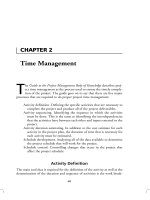Chapter 2 decision makring
Bạn đang xem bản rút gọn của tài liệu. Xem và tải ngay bản đầy đủ của tài liệu tại đây (193.06 KB, 32 trang )
Chapter 2
Consumers as Decision Makers
Chapter Objective
•
Consumer decision-making is a central part of consumer behavior, but the ways we evaluate and choose products (and the amount of thought
we put into these choices) varies widely, depending upon such dimensions as the degree of novelty or risk related to the decision.
•
A purchase decision actually is composed of a series of stages that results in the selection of one product over competing options.
•
Decision-making is not always rational.
•
Our access to online sources is changing the way we decide what to buy.
•
We often fall back on well-learned “rules of thumb” to make decisions.
•
Consumers rely upon different decision rules when they evaluate competing options.
Learning Objective 1
•
•
•
•
Steps in the decision-making process
Consumers today
Consumer make rational perspective
Types of Consumer Decisions
The Decision-Making Process
•
There are several steps in the decision-making process:
•
Consumers today may have too many choices; this is known as consumer hyperchoice.
– Problem recognition
– Information search
– Evaluation of alternatives
– Product choice
Perspectives on Decision Making
•
Consumer make rational perspective.
– use the economics of information approach to the search process, gathering information
until the rewards (utility) of doing so no longer exceed the costs.
– integrate as much information as possible with what they already know about a product,
weigh the pluses and minuses of each alternative, and arrive at a satisfactory decision.
– Though this approach is correct in many instances, it does not describe all forms of decisionmaking.
•
•
Purchase momentum occurs when initial impulses increase the likelihood that we will
buy even more than we need.
People differ in terms of their cognitive processing style.
– Some use a rational system of cognition (process information analytically and sequentially).
– Others rely on an experiential system of cognition (process information holistically and in
parallel).
– What really happens is that people use multiple strategies and the thought process is known as
constructive processing. It means that we evaluate what we need to do to get the job done and
that is how much effort we expend.
Types of Consumer Decisions
(1) Extended problem solving
•
•
relates to our self-concept and the outcome may be risky.
•
Extended problem solving has grown in the online space due to the popularity of social games
(multiplayer, competitive goal-oriented activity with defined rules of engagement and online
connectivity among a community of players).
•
Information search can be from memory (internal search) and outside sources (external
search).
Game-based marketing – offer a targeted audience
(2) Limited problem solving - more straightforward and simple.
•
We use decision rules to choose among alternatives because we are not as motivated
to search or information or to evaluate alternatives.
•
We fall back on general guidelines/cognitive shortcuts instead of starting from scratch
every time we need to decide.
(3) Habitual decision-making - occurs with little
to no conscious effort.
– We make the choices using a process called automaticity.
– Habitual decision-making minimizes time and energy spent on mundane purchase
decisions.
(4) Mental Accounting: Biases in the Decision-Making Process
•
•
•
•
•
•
Mental accounting helps to explain the way we post a problem (called framing) and
whether it is phrased in terms of gains or losses influences our decision.
The sunk-cost fallacy says that having paid for something makes us reluctant to waste it.
Behavioral economics blends psychology and economics to study how consumers make
decisions.
Anchoring refers to the fact that when people are given a number, they use that number
as the standard for future judgments.
When people are obsessed with preparing for the future so they cannot enjoy the
present it is called hyperopia
Prospect theory defines choice in terms of gains and losses.
(5) A shopping bot - website dedicated to comparison shopping. These sites may
center on a single type of product, or may provide comparisons of many
different products. Bot is short for robot.
Discuss
•
What biases do you have when you search for (a) a car, (b) a computer, and (c) a
university or college?
Discuss
What would be the risk in using a shopping ’bot? Explain how using a shopping
’bot could be advantageous.
(2) How much do we search?
•
•
•
•
•
•
•
As a rule, we search more when the purchase is important, when we
have more of a need to learn more about the purchase, or when it is
easy to obtain the relevant information.
Some people search more than others do.
Younger, better-educated people conduct more information search.
Women are more inclined to search than men do.
Those who place a greater value on image and style search more.
Moderately knowledgeable consumers search more than experts or
novices. Experts engage in selective search (focused and efficient
efforts) while novices rely on others’ opinions and nonfunctional
attributes (name brand, price), focusing on details vs. the big picture.
The blissful ignorance effect describes the phenomenon where those
who have details about a product before they buy it do not expect to be
as happy with it as do those who got only ambiguous information.
(3) As a rule, purchase decisions that involve extensive search also entail some kind
of perceived risk or belief that the product has potentially negative
consequences. There are five kinds of risk
•
•
•
•
•
Monetary risk
Functional risk
Physical risk
Social risk
Psychological risk
Learning Objective 2
•
•
•
•
Product Choice: How Do We Select from the Alternatives?
Evaluation
Product Knowledge
Product categorization
Product Choice: How Do We Select from the Alternatives?
(1) How Do We Decide Among Alternatives?
•
•
The alternatives a consumer knows about make up his evoked set.
Alternatives that are actively considered during a consumer’s choice process are
his or her consideration set.
Product Choice: How Do We Select from the Alternatives?
(2) Evaluation is made difficult due to feature creep – more and newer features
being added to products.
•
•
Evaluative criteria are the dimensions used to judge the merits of competing
options.
Determinant attributes are the features we actually use to differentiate among
our choices.
•
•
•
•
In order for a marketer to effectively recommend a new decision criterion, it
should convey three pieces of information:
there are significant differences among the brands on the attribute.
Should supply the consumer with a decision-making rule.
convey a rule that is consistent with how the person made the decision in the
past.
(3) Product categorization is how consumers organize their beliefs about products or services.
•
This knowledge is represented in a consumer’s knowledge structure (the set of beliefs
and the way these beliefs are organized in our minds). There are several levels of
categorization:
– Basic level category—typically most useful; items have a lot in common but broad range of
alternatives can be considered.
– Superordinate category—abstract concepts.
– Subordinate level—individual brands; prototypical items help describe subordinate level.
(4) Product categorization has many strategic implications. Some of these are:
•
•
•
•
Position a product—The conception of the product relative to other products in the consumer’s mind,
or positioning strategy, hinges on the extent to which the consumer categorizes a product.
Identify competitors—Do different products act as substitutes?
Create an exemplar product—The most known, accepted product or brand can be a category
exemplar that exerts disproportionate influence on how people think of the category.
Locate products in the store—Consumers often expect to find certain products within certain places
within the store environment.
Discussion
Ask students to write down as many brands of soft drinks (or potato chips, or cars,
or cologne, etc.) as they can think of in 60 seconds. Of this group (in each case),
ask students to consider which they would consider purchasing. How could
marketers that represent that group you did not select move into your preferred
evoked set?
Cybermediaries
•
business that is growing to meet the demand for information and service on the
Web is the cybermediary. This intermediary helps to filter and organize online
market information so that customers can identify and evaluate alternatives
more efficiently.
•
Electronic recommendation agents are software tools that try to understand a
human decision maker’s multi-attribute preferences for a product category by
asking the user to communicate his preferences.
•
•
About 80% of online shoppers rely on customer reviews before they buy. The
people who supply these reviews are known as brand advocates.
People who provide reviews do so to boost their reputation as knowledgeable
advisors. This is known as the reputation economy.
Learning Objective 3
•
•
Loyalty & Habit
Decision Rules
Brand Loyalty or Habit?
•
•
•
•
Zipf’s Law - describes our tendency to prefer a number-one brand to the competition,
which helps explain why brands that dominate their markets are as much as 50% more
profitable than their nearest competitors.
Many people tend to buy the same brand just about every time they go to the store. This
consistent pattern is due to inertia, where a brand is bought out of habit merely because
less effort is required.
Marketers find it easy to unfreeze our habit with promotional offers when we have little or
no underlying commitment to a brand. Consumers who flit from brand to brand to get
deals are called brand sluts.
Brand loyalty is a form of repeat purchasing behavior reflecting a conscious decision to
continue buying the same brand.









